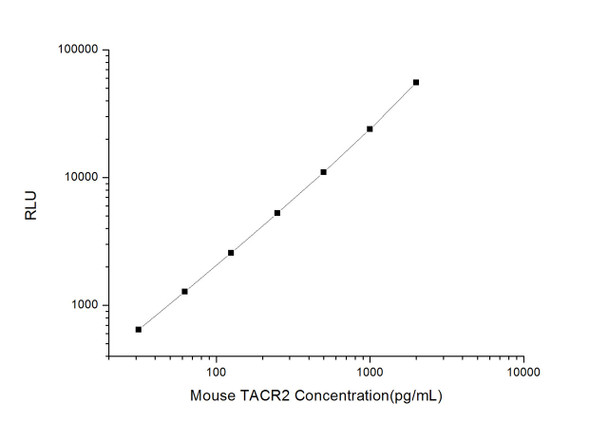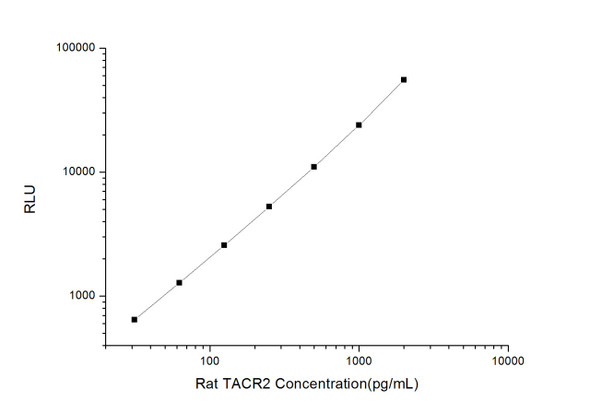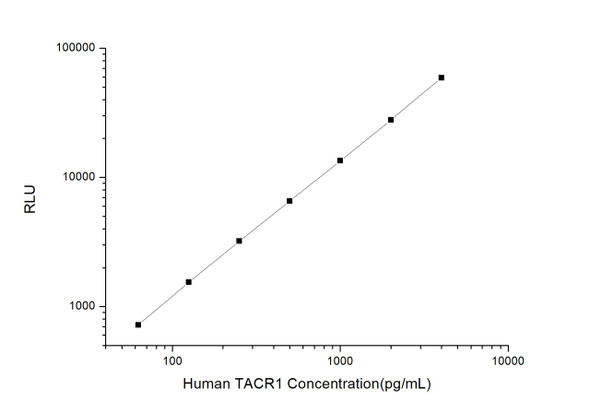Mouse Cell Biology ELISA Kits 2
Mouse TACR2 (Tachykinin Receptor 2) CLIA Kit (MOES00547)
- SKU:
- MOES00547
- Product Type:
- ELISA Kit
- ELISA Type:
- CLIA Kit
- Size:
- 96 Assays
- Sensitivity:
- 18.75pg/mL
- Range:
- 31.25-2000pg/mL
- ELISA Type:
- Sandwich
- Reactivity:
- Mouse
- Sample Type:
- Serum, plasma and other biological fluids
- Research Area:
- Cell Biology
Description
| Assay type: | Sandwich |
| Format: | 96T |
| Assay time: | 4.5h |
| Reactivity: | Mouse |
| Detection method: | Chemiluminescence |
| Detection range: | 31.25-2000 pg/mL |
| Sensitivity: | 18.75 pg/mL |
| Sample volume: | 100µL |
| Sample type: | Serum, plasma and other biological fluids |
| Repeatability: | CV < 15% |
| Specificity: | This kit recognizes Mouse TACR2 in samples. No significant cross-reactivity or interference between Mouse TACR2 and analogues was observed. |
This kit uses Sandwich-CLIA as the method. The micro CLIA plate provided in this kit has been pre-coated with an antibody specific to Mouse TACR2. Standards or samples are added to the appropriate micro CLIA plate wells and combined with the specific antibody. Then a biotinylated detection antibody specific for Mouse TACR2 and Avidin-Horseradish Peroxidase (HRP) conjugate are added to each micro plate well successively and incubated. Free components are washed away. The substrate solution is added to each well. Only those wells that contain Mouse TACR2, biotinylated detection antibody and Avidin-HRP conjugate will appear fluorescence. The Relative light unit (RLU) value is measured spectrophotometrically by the Chemiluminescence immunoassay analyzer. The RLU value is positively associated with the concentration of Mouse TACR2. The concentration of Mouse TACR2 in the samples can be calculated by comparing the RLU of the samples to the standard curve.
| UniProt Protein Function: | TACR2: This is a receptor for the tachykinin neuropeptide substance K (neurokinin A). It is associated with G proteins that activate a phosphatidylinositol-calcium second messenger system. The rank order of affinity of this receptor to tachykinins is: substance K > neuromedin-K > substance P. Belongs to the G-protein coupled receptor 1 family. |
| UniProt Protein Details: | Protein type:GPCR, family 1; Receptor, GPCR; Membrane protein, integral; Membrane protein, multi-pass; Motility/polarity/chemotaxis Chromosomal Location of Human Ortholog: 10q22. 1 Cellular Component: integral to plasma membrane; plasma membrane Molecular Function:substance K receptor activity; protein binding; tachykinin receptor activity Biological Process: negative regulation of luteinizing hormone secretion; tachykinin signaling pathway; muscle contraction; intestine smooth muscle contraction; operant conditioning; response to electrical stimulus; excretion; positive regulation of vascular permeability; positive regulation of acetylcholine secretion |
| NCBI Summary: | This gene belongs to a family of genes that function as receptors for tachykinins. Receptor affinities are specified by variations in the 5'-end of the sequence. The receptors belonging to this family are characterized by interactions with G proteins and 7 hydrophobic transmembrane regions. This gene encodes the receptor for the tachykinin neuropeptide substance K, also referred to as neurokinin A. [provided by RefSeq, Jul 2008] |
| UniProt Code: | P21452 |
| NCBI GenInfo Identifier: | 229462950 |
| NCBI Gene ID: | 6865 |
| NCBI Accession: | P21452. 3 |
| UniProt Secondary Accession: | P21452,Q4QRI5, Q8NGQ8, Q9UDE6, Q9UDE7, A8K7I1, |
| UniProt Related Accession: | P21452 |
| Molecular Weight: | 398 |
| NCBI Full Name: | Substance-K receptor |
| NCBI Synonym Full Names: | tachykinin receptor 2 |
| NCBI Official Symbol: | TACR2 |
| NCBI Official Synonym Symbols: | SKR; NK2R; NKNAR; TAC2R |
| NCBI Protein Information: | substance-K receptor; NK-2R; NK-2 receptor; substance K receptor; neurokinin 2 receptor; neurokinin A receptor; seven transmembrane helix receptor |
| UniProt Protein Name: | Substance-K receptor |
| UniProt Synonym Protein Names: | NK-2 receptor; NK-2R; Neurokinin A receptor; Tachykinin receptor 2 |
| Protein Family: | Substance-K receptor |
| UniProt Gene Name: | TACR2 |
| UniProt Entry Name: | NK2R_HUMAN |
As the RLU values of the standard curve may vary according to the conditions of the actual assay performance (e. g. operator, pipetting technique, washing technique or temperature effects), the operator should establish a standard curve for each test. Typical standard curve and data is provided below for reference only.
| Concentration (pg/mL) | RLU | Average | Corrected |
| 2000 | 53446 57996 | 55721 | 55693 |
| 1000 | 23203 24745 | 23974 | 23946 |
| 500 | 11469 10595 | 11032 | 11004 |
| 250 | 4825 5763 | 5294 | 5266 |
| 125 | 2665 2551 | 2608 | 2580 |
| 62.5 | 1376 1246 | 1311 | 1283 |
| 31.25 | 672 676 | 674 | 646 |
| 0 | 27 29 | 28 | -- |
Precision
Intra-assay Precision (Precision within an assay): 3 samples with low, mid range and high level Mouse TACR2 were tested 20 times on one plate, respectively.
Inter-assay Precision (Precision between assays): 3 samples with low, mid range and high level Mouse TACR2 were tested on 3 different plates, 20 replicates in each plate.
| Intra-assay Precision | Inter-assay Precision | |||||
| Sample | 1 | 2 | 3 | 1 | 2 | 3 |
| n | 20 | 20 | 20 | 20 | 20 | 20 |
| Mean (pg/mL) | 103.79 | 241.46 | 780.88 | 105.95 | 245.91 | 748.97 |
| Standard deviation | 8.83 | 23.93 | 48.10 | 12.37 | 17.36 | 68.61 |
| C V (%) | 8.51 | 9.91 | 6.16 | 11.68 | 7.06 | 9.16 |
Recovery
The recovery of Mouse TACR2 spiked at three different levels in samples throughout the range of the assay was evaluated in various matrices.
| Sample Type | Range (%) | Average Recovery (%) |
| Serum (n=5) | 90-102 | 95 |
| EDTA plasma (n=5) | 90-100 | 95 |
| Cell culture media (n=5) | 91-105 | 98 |
Linearity
Samples were spiked with high concentrations of Mouse TACR2 and diluted with Reference Standard & Sample Diluent to produce samples with values within the range of the assay.
| Serum (n=5) | EDTA plasma (n=5) | Cell culture media (n=5) | ||
| 1:2 | Range (%) | 86-100 | 97-112 | 86-100 |
| Average (%) | 93 | 104 | 93 | |
| 1:4 | Range (%) | 85-100 | 88-103 | 91-103 |
| Average (%) | 92 | 94 | 96 | |
| 1:8 | Range (%) | 99-116 | 85-100 | 89-104 |
| Average (%) | 106 | 92 | 95 | |
| 1:16 | Range (%) | 97-111 | 100-116 | 90-102 |
| Average (%) | 103 | 108 | 97 |
An unopened kit can be stored at 4°C for 1 month. If the kit is not used within 1 month, store the items separately according to the following conditions once the kit is received.
| Item | Specifications | Storage |
| Micro CLIA Plate(Dismountable) | 8 wells ×12 strips | -20°C, 6 months |
| Reference Standard | 2 vials | |
| Concentrated Biotinylated Detection Ab (100×) | 1 vial, 120 µL | |
| Concentrated HRP Conjugate (100×) | 1 vial, 120 µL | -20°C(shading light), 6 months |
| Reference Standard & Sample Diluent | 1 vial, 20 mL | 4°C, 6 months |
| Biotinylated Detection Ab Diluent | 1 vial, 14 mL | |
| HRP Conjugate Diluent | 1 vial, 14 mL | |
| Concentrated Wash Buffer (25×) | 1 vial, 30 mL | |
| Substrate Reagent A | 1 vial, 5 mL | 4°C (shading light) |
| Substrate Reagent B | 1 vial, 5 mL | 4°C (shading light) |
| Plate Sealer | 5 pieces | |
| Product Description | 1 copy | |
| Certificate of Analysis | 1 copy |
- Set standard, test sample and control (zero) wells on the pre-coated plate and record theirpositions. It is recommended to measure each standard and sample in duplicate. Note: addall solutions to the bottom of the plate wells while avoiding contact with the well walls. Ensuresolutions do not foam when adding to the wells.
- Aliquot 100 µL of standard solutions into the standard wells.
- Add 100 µL of Sample / Standard dilution buffer into the control (zero) well.
- Add 100 µL of properly diluted sample (serum, plasma, tissue homogenates and otherbiological fluids. ) into test sample wells.
- Cover the plate with the sealer provided in the kit and incubate for 90 min at 37 °C.
- Aspirate the liquid from each well, do not wash. Immediately add 100 µL of BiotinylatedDetection Ab working solution to each well. Cover the plate with a plate seal and gently mix. Incubate for 1 hour at 37 °C.
- Aspirate or decant the solution from the plate and add 350 µL of wash buffer to each welland incubate for 1-2 minutes at room temperature. Aspirate the solution from each well andclap the plate on absorbent filter paper to dry. Repeat this process 3 times. Note: a microplatewasher can be used in this step and other wash steps.
- Add 100 µL of HRP Conjugate working solution to each well. Cover with a plate seal andincubate for 30 min at 37 °C.
- Aspirate or decant the solution from each well. Repeat the wash process for five times asconducted in step 7.
- Add 100 µL of Substrate mixture solution to each well. Cover with a new plate seal andincubate for no more than 5 min at 37 °C. Protect the plate from light.
- Determine the RLU value of each well immediately.






